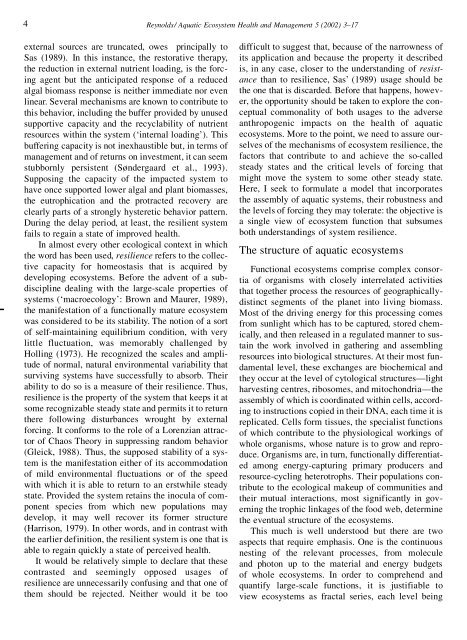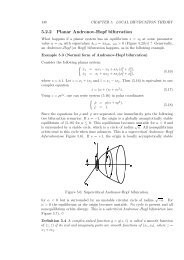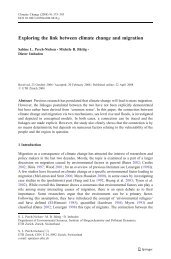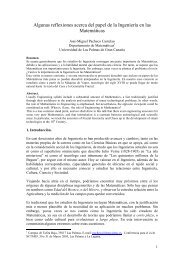Resilience in aquatic ecosystems - hysteresis, homeostasis, and ...
Resilience in aquatic ecosystems - hysteresis, homeostasis, and ...
Resilience in aquatic ecosystems - hysteresis, homeostasis, and ...
Create successful ePaper yourself
Turn your PDF publications into a flip-book with our unique Google optimized e-Paper software.
4<br />
Reynolds/ Aquatic Ecosystem Health <strong>and</strong> Management 5 (2002) 3–17<br />
external sources are truncated, owes pr<strong>in</strong>cipally to<br />
Sas (1989). In this <strong>in</strong>stance, the restorative therapy,<br />
the reduction <strong>in</strong> external nutrient load<strong>in</strong>g, is the forc<strong>in</strong>g<br />
agent but the anticipated response of a reduced<br />
algal biomass response is neither immediate nor even<br />
l<strong>in</strong>ear. Several mechanisms are known to contribute to<br />
this behavior, <strong>in</strong>clud<strong>in</strong>g the buffer provided by unused<br />
supportive capacity <strong>and</strong> the recyclability of nutrient<br />
resources with<strong>in</strong> the system (‘<strong>in</strong>ternal load<strong>in</strong>g’). This<br />
buffer<strong>in</strong>g capacity is not <strong>in</strong>exhaustible but, <strong>in</strong> terms of<br />
management <strong>and</strong> of returns on <strong>in</strong>vestment, it can seem<br />
stubbornly persistent (Søndergaard et al., 1993).<br />
Suppos<strong>in</strong>g the capacity of the impacted system to<br />
have once supported lower algal <strong>and</strong> plant biomasses,<br />
the eutrophication <strong>and</strong> the protracted recovery are<br />
clearly parts of a strongly hysteretic behavior pattern.<br />
Dur<strong>in</strong>g the delay period, at least, the resilient system<br />
fails to rega<strong>in</strong> a state of improved health.<br />
In almost every other ecological context <strong>in</strong> which<br />
the word has been used, resilience refers to the collective<br />
capacity for <strong>homeostasis</strong> that is acquired by<br />
develop<strong>in</strong>g <strong>ecosystems</strong>. Before the advent of a subdiscipl<strong>in</strong>e<br />
deal<strong>in</strong>g with the large-scale properties of<br />
systems (‘macroecology’: Brown <strong>and</strong> Maurer, 1989),<br />
the manifestation of a functionally mature ecosystem<br />
was considered to be its stability. The notion of a sort<br />
of self-ma<strong>in</strong>ta<strong>in</strong><strong>in</strong>g equilibrium condition, with very<br />
little fluctuation, was memorably challenged by<br />
Holl<strong>in</strong>g (1973). He recognized the scales <strong>and</strong> amplitude<br />
of normal, natural environmental variability that<br />
surviv<strong>in</strong>g systems have successfully to absorb. Their<br />
ability to do so is a measure of their resilience. Thus,<br />
resilience is the property of the system that keeps it at<br />
some recognizable steady state <strong>and</strong> permits it to return<br />
there follow<strong>in</strong>g disturbances wrought by external<br />
forc<strong>in</strong>g. It conforms to the role of a Lorenzian attractor<br />
of Chaos Theory <strong>in</strong> suppress<strong>in</strong>g r<strong>and</strong>om behavior<br />
(Gleick, 1988). Thus, the supposed stability of a system<br />
is the manifestation either of its accommodation<br />
of mild environmental fluctuations or of the speed<br />
with which it is able to return to an erstwhile steady<br />
state. Provided the system reta<strong>in</strong>s the <strong>in</strong>ocula of component<br />
species from which new populations may<br />
develop, it may well recover its former structure<br />
(Harrison, 1979). In other words, <strong>and</strong> <strong>in</strong> contrast with<br />
the earlier def<strong>in</strong>ition, the resilient system is one that is<br />
able to rega<strong>in</strong> quickly a state of perceived health.<br />
It would be relatively simple to declare that these<br />
contrasted <strong>and</strong> seem<strong>in</strong>gly opposed usages of<br />
resilience are unnecessarily confus<strong>in</strong>g <strong>and</strong> that one of<br />
them should be rejected. Neither would it be too<br />
difficult to suggest that, because of the narrowness of<br />
its application <strong>and</strong> because the property it described<br />
is, <strong>in</strong> any case, closer to the underst<strong>and</strong><strong>in</strong>g of resistance<br />
than to resilience, Sas’ (1989) usage should be<br />
the one that is discarded. Before that happens, however,<br />
the opportunity should be taken to explore the conceptual<br />
commonality of both usages to the adverse<br />
anthropogenic impacts on the health of <strong>aquatic</strong><br />
<strong>ecosystems</strong>. More to the po<strong>in</strong>t, we need to assure ourselves<br />
of the mechanisms of ecosystem resilience, the<br />
factors that contribute to <strong>and</strong> achieve the so-called<br />
steady states <strong>and</strong> the critical levels of forc<strong>in</strong>g that<br />
might move the system to some other steady state.<br />
Here, I seek to formulate a model that <strong>in</strong>corporates<br />
the assembly of <strong>aquatic</strong> systems, their robustness <strong>and</strong><br />
the levels of forc<strong>in</strong>g they may tolerate: the objective is<br />
a s<strong>in</strong>gle view of ecosystem function that subsumes<br />
both underst<strong>and</strong><strong>in</strong>gs of system resilience.<br />
The structure of <strong>aquatic</strong> <strong>ecosystems</strong><br />
Functional <strong>ecosystems</strong> comprise complex consortia<br />
of organisms with closely <strong>in</strong>terrelated activities<br />
that together process the resources of geographicallydist<strong>in</strong>ct<br />
segments of the planet <strong>in</strong>to liv<strong>in</strong>g biomass.<br />
Most of the driv<strong>in</strong>g energy for this process<strong>in</strong>g comes<br />
from sunlight which has to be captured, stored chemically,<br />
<strong>and</strong> then released <strong>in</strong> a regulated manner to susta<strong>in</strong><br />
the work <strong>in</strong>volved <strong>in</strong> gather<strong>in</strong>g <strong>and</strong> assembl<strong>in</strong>g<br />
resources <strong>in</strong>to biological structures. At their most fundamental<br />
level, these exchanges are biochemical <strong>and</strong><br />
they occur at the level of cytological structures—light<br />
harvest<strong>in</strong>g centres, ribosomes, <strong>and</strong> mitochondria—the<br />
assembly of which is coord<strong>in</strong>ated with<strong>in</strong> cells, accord<strong>in</strong>g<br />
to <strong>in</strong>structions copied <strong>in</strong> their DNA, each time it is<br />
replicated. Cells form tissues, the specialist functions<br />
of which contribute to the physiological work<strong>in</strong>gs of<br />
whole organisms, whose nature is to grow <strong>and</strong> reproduce.<br />
Organisms are, <strong>in</strong> turn, functionally differentiated<br />
among energy-captur<strong>in</strong>g primary producers <strong>and</strong><br />
resource-cycl<strong>in</strong>g heterotrophs. Their populations contribute<br />
to the ecological makeup of communities <strong>and</strong><br />
their mutual <strong>in</strong>teractions, most significantly <strong>in</strong> govern<strong>in</strong>g<br />
the trophic l<strong>in</strong>kages of the food web, determ<strong>in</strong>e<br />
the eventual structure of the <strong>ecosystems</strong>.<br />
This much is well understood but there are two<br />
aspects that require emphasis. One is the cont<strong>in</strong>uous<br />
nest<strong>in</strong>g of the relevant processes, from molecule<br />
<strong>and</strong> photon up to the material <strong>and</strong> energy budgets<br />
of whole <strong>ecosystems</strong>. In order to comprehend <strong>and</strong><br />
quantify large-scale functions, it is justifiable to<br />
view <strong>ecosystems</strong> as fractal series, each level be<strong>in</strong>g






